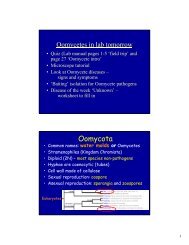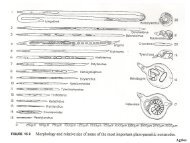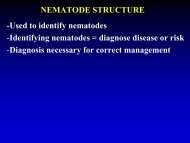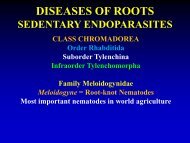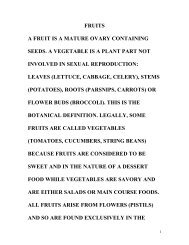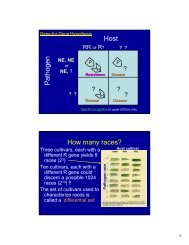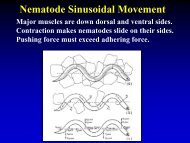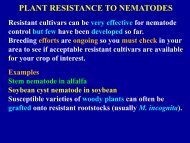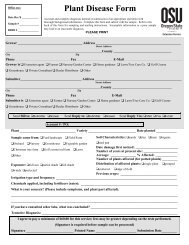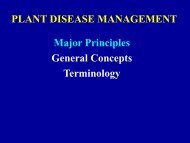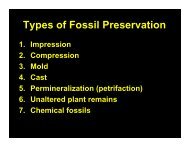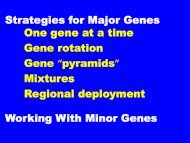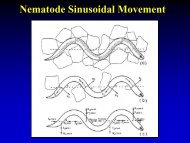DISEASES OF ROOTS MIGRATORY ECTOPARASITES
DISEASES OF ROOTS MIGRATORY ECTOPARASITES
DISEASES OF ROOTS MIGRATORY ECTOPARASITES
Create successful ePaper yourself
Turn your PDF publications into a flip-book with our unique Google optimized e-Paper software.
<strong>DISEASES</strong> <strong>OF</strong> <strong>ROOTS</strong><br />
<strong>MIGRATORY</strong> <strong>ECTOPARASITES</strong><br />
-Most common type of plant parasitic nematode<br />
-Life cycles simple and similar<br />
-Most genera have many species<br />
-Most have wide host ranges<br />
-Pathology similar but severity and thresholds vary<br />
-Nematicides primary control measure, if available
<strong>MIGRATORY</strong> <strong>ECTOPARASITES</strong><br />
LIFE CYCLE
<strong>DISEASES</strong> <strong>OF</strong> <strong>ROOTS</strong><br />
<strong>MIGRATORY</strong> <strong>ECTOPARASITES</strong><br />
CLASS CHROMADOREA<br />
Order Rhabditida<br />
Suborder Tylenchina<br />
Infraorder Tylenchomorpha<br />
Family Dolichodoridae<br />
Dolichodorus = “awl” nematodes, 16 species<br />
Based on shape of stylet
<strong>DISEASES</strong> <strong>OF</strong> <strong>ROOTS</strong><br />
<strong>MIGRATORY</strong> <strong>ECTOPARASITES</strong><br />
CLASS CHROMADOREA<br />
Order Rhabditida<br />
Suborder Tylenchina<br />
Infraorder Tylenchomorpha<br />
Family Dolichodoridae<br />
Belonolaimus = 10 species<br />
Belonolaimus longicaudatus = “sting” nematode
*<br />
Agrios
Belonolaimus<br />
Female Tail<br />
Dolichodorus<br />
Female Tail<br />
Belonolaimus<br />
Male Tail<br />
Dolichodorus<br />
Male Tail
Belonolaimus longicaudatus = sting nematode<br />
Life cycle and biology<br />
- The most damaging migratory ectoparasite.<br />
- Very serious on a wide variety of crops in the<br />
southeastern US = corn and many other vegetables,<br />
cotton, peanuts, soybean, turf and pasture grasses,<br />
forest trees.<br />
- Most prominent in warm sandy (80%) soils where<br />
they can completely destroy a crop.<br />
- Life cycle is about 4 weeks.
Belonolaimus longicaudatus = sting nematode<br />
Stylet thrusts deep<br />
into roots<br />
= local lesions<br />
Soybean<br />
Stubby or coarse roots<br />
may be present<br />
L.I. Miller<br />
Nemapix 1
Belonolaimus longicaudatus = sting nematode<br />
-Feed on root tips or<br />
on sides of root.<br />
-Feeding on one side<br />
stops growth, other side<br />
continues to grow<br />
so root curves.<br />
Soybean<br />
L.I. Miller<br />
Nemapix 1
Belonolaimus longicaudatus = sting nematode<br />
Plants wilt, appear chlorotic and are reduced in size.<br />
In severe infestations the entire crop may die.<br />
L.I. Miller<br />
Nemapix 1
Belonolaimus longicaudatus = sting nematode<br />
Symptoms<br />
- Root system is greatly reduced,<br />
- Increase in lateral root production = "blind root tip"<br />
- Secondary invasion my other bacteria and fungi<br />
Interacts with Fusarium on cotton.<br />
- Water and nutrient uptake are greatly reduced.
Belonolaimus longicaudatus = sting nematode<br />
Control<br />
Physical incorporation of nonfumigant granular<br />
nematicides (aldicarb, carbofuran, dasanit).<br />
Soil fumigation<br />
Up to 500% yield<br />
increases have been<br />
reported when<br />
controlled.<br />
Cabbage<br />
SON<br />
Nemapix 1
<strong>DISEASES</strong> <strong>OF</strong> <strong>ROOTS</strong><br />
<strong>MIGRATORY</strong> <strong>ECTOPARASITES</strong><br />
CLASS CHROMADOREA<br />
Order Rhabditida<br />
Suborder Tylenchina<br />
Infraorder Tylenchomorpha<br />
Family Dolichodoridae<br />
Tylenchorhynchus = “stunt” nematodes, 130+ species<br />
Several morphologically similar genera, 250+ species
*<br />
Agrios
Tylenchorhynchus sp.<br />
U. Zunke<br />
Nemapix 2
Tylenchorhynchus = stunt nematode<br />
Life cycle and biology<br />
-Common on roots of many plants.<br />
-Feed on epidermal cells in the region of root elongation<br />
and region of root hairs<br />
- Rarely important unless in very high numbers<br />
such as tobacco, turf grasses, pastures, corn.<br />
- Common in grassland and rangeland.<br />
- Can be serious on azaleas, African violet, pines<br />
Symptoms<br />
Large numbers debilitate roots, tops become stunted and<br />
chlorotic, and yield may be reduced<br />
Control<br />
Nematicides
<strong>DISEASES</strong> <strong>OF</strong> <strong>ROOTS</strong><br />
<strong>MIGRATORY</strong> <strong>ECTOPARASITES</strong><br />
CLASS CHROMADOREA<br />
Order Rhabditida<br />
Suborder Tylenchina<br />
Infraorder Tylenchomorpha<br />
Family Hoplolaimidae<br />
Hoplolaimus = “lance” nematodes, 30+ species
*<br />
Agrios
Hoplolaimus<br />
1-2 mm in length
Hoplolaimus = “lance” nematodes<br />
Life cycle and biology<br />
-Usually ectoparasites but sometimes may be found<br />
partly or entirely within root tissues<br />
= semi-endoparasite -> endoparasite.<br />
- May be ectoparasite on young roots and endoparasite<br />
on older roots.<br />
- Life cycle can be 6-7 weeks.<br />
- In high populations may damage many different crops;<br />
grasses, cotton, pine, oak, wheat, banana, sugarcane,<br />
corn, soybean, coffee, tea, turf and forest trees.
Hoplolaimus = “lance” nematodes<br />
Life cycle and biology<br />
- Nematode kills cells of cortex or of the vascular tissue<br />
=> extreme necrotic lesions extending to cells some<br />
distance beyond those directly adjacent to the parasite.<br />
Extensive invasion results in destruction of large areas<br />
of root including phloem and xylem tissues.<br />
Can impede mycorrhizal associations of pine trees,<br />
which are essential for the normal growth of trees.
Hoplolaimus = “lance” nematodes<br />
Symptoms<br />
- Stunting, chlorosis, wilting, yield reduction.<br />
- Yellow, red or brown necrotic areas on root<br />
=> depends on density and/or the duration of feeding.<br />
- Holes in cortex
Stunting and chlorosis of soybean caused by lance<br />
nematode, Hoplolaimus columbus<br />
S. Koenning<br />
Nemapix 2
Hoplolaimus = “lance” nematodes<br />
Control<br />
- Soil fumigation<br />
- Nematicides<br />
- Dips for sprigs of Bermuda grass.<br />
- Fallowing may help but H. columbus survived storage<br />
in dry soil for 5 years.
<strong>DISEASES</strong> <strong>OF</strong> <strong>ROOTS</strong><br />
<strong>MIGRATORY</strong> <strong>ECTOPARASITES</strong><br />
CLASS CHROMADOREA<br />
Order Rhabditida<br />
Suborder Tylenchina<br />
Infraorder Tylenchomorpha<br />
Family Hoplolaimidae<br />
“Spiral Nematodes”<br />
Scutellonema spp.<br />
Rotylenchus spp. – 80+ species<br />
Helicotylenchus spp. – 160+ species
*<br />
Agrios
Scutellonema<br />
Life cycle and biology<br />
- Feed as ectoparasites on roots of cotton, coconut,<br />
banana, corn, ornamentals, peanut.<br />
- S. bradys = “yam nematode”<br />
- In tuber crops (yams) and bulbs (lilies) also feeds as a<br />
migratory endoparasite.<br />
- Large populations can develop during storage 6000/g!
Scutellonema<br />
Symptoms<br />
- Causes lesions in superficial tissues under tuber skin.<br />
Turn yellow – brown – black.<br />
- In stored tubers, may cause dry rot if bacteria are not<br />
present or wet rot if bacteria are present.<br />
Fusarium may also be present.<br />
Can lead to complete tuber destruction.<br />
Control<br />
Yams = plant nematode-free tubers,<br />
Hot water treatment or soaking seed in nematicides.<br />
Field application of nematicides.
Scutellonema bradys damage to yam<br />
Flickr<br />
IITA Images
Rotylenchus spp. = “spiral” nematodes<br />
Life cycle and biology<br />
- Migratory ectoparasite but may enter root partly or<br />
wholly during feeding.<br />
- Occasionally referred to as a sedentary ectoparasite or an<br />
ecto-endoparasite but does not stay permanently attached.<br />
- Life cycle is about 100 days at 23 C on ryegrass.<br />
- Reach high levels in sandy soils.<br />
- Important on vegetables, lilies, grasses, ornamentals,<br />
shrubs and trees, especially boxwood.<br />
- 6/g soil can damage carrots (= 1,500/250 g soil).<br />
- 0.5/g soil can cause root rot of lilies (= 125/250 g soil).
Rotylenchus spp. = “spiral” nematodes<br />
Symptoms<br />
- Lesions result from death of cells during feeding.<br />
- Multiple attacks weaken root.<br />
- Top growth is reduced.<br />
- Leaves of some hosts become yellow<br />
Control<br />
Nematicides
Helicotylenchus spp. = “spiral” nematodes<br />
Life cycle and biology<br />
- Common genus with many species.<br />
-Ectoparasites -> semi-endoparasites or ecto-endo<br />
parasite, occasionally referred to as a migratory<br />
endoparasite but doesn't move about actively in roots.<br />
-Important on hardwood trees, turf, soybean, olive,<br />
cotton, millet, tomatoes.<br />
-Most important on banana!<br />
H. multicinctus
Helicotylenchus sp.
Helicotylenchus spp. = “spiral” nematodes<br />
Symptoms<br />
-Invades cortex -> lesions developing to root rots<br />
with other pathogens (Fusarium, Rhizoctonia).<br />
-Since banana is propagated vegetatively, infection is<br />
spread by planting infested rhizomes.<br />
-Weakened root systems can cause plants to fall over<br />
in high winds.
Helicotylenchus spp. = “spiral” nematodes<br />
Control<br />
- Fumigation<br />
- Strict sanitation - rotted tissue pared away from<br />
rhizome sets.<br />
Sets are then treated with hot water (20 minutes at<br />
53-55 C) and/or dipped in nematicide.<br />
- Some genetic resistance in cotton.
<strong>DISEASES</strong> <strong>OF</strong> <strong>ROOTS</strong><br />
<strong>MIGRATORY</strong> <strong>ECTOPARASITES</strong><br />
CLASS CHROMADOREA<br />
Order Rhabditida<br />
Suborder Tylenchina<br />
Infraorder Tylenchomorpha<br />
Family Tylenchulidae<br />
Paratylenchus spp. = “pin” nematodes
Paratylenchus sp.
Paratylenchus sp.
*<br />
Agrios
Paratylenchus spp. = “pin” nematodes<br />
Life cycle and biology<br />
- Common in many native and agro-ecosystems.<br />
- J4's lack stylet and can survive in soil for long<br />
periods without feeding (1 year+)<br />
- Apparently require root exudate to stimulate<br />
final molt.<br />
-In Oregon can damage peppermint when in high<br />
numbers, can reach 100/g soil (=25,000/250 g soil)!<br />
High densities in fall can contribute to winter injury.
Paratylenchus spp. = “pin” nematodes<br />
Life cycle and biology<br />
- Feed on epidermal cells or at base of root hair.<br />
-May feed in one spot for long period of several<br />
days without killing cell.<br />
Symptoms<br />
-However, large populations can cause brown<br />
necrotic areas and/or kill root.
Paratylenchus spp. = “pin” nematodes<br />
Control<br />
- Control seldom warranted unless in very high<br />
densities.<br />
- Nematicides only known control.<br />
- Appear to be more resistant to nematicides than most<br />
nematodes.
<strong>DISEASES</strong> <strong>OF</strong> <strong>ROOTS</strong><br />
<strong>MIGRATORY</strong> <strong>ECTOPARASITES</strong><br />
CLASS CHROMADOREA<br />
Order Rhabditida<br />
Suborder Tylenchina<br />
Infraorder Tylenchomorpha<br />
Family Criconematidae<br />
Criconemoides spp. = “ring” nematodes<br />
Also been known as:<br />
Criconemella<br />
Mesocriconema<br />
Macroposthonia
*<br />
Agrios
Criconemoides = “ring” nematodes<br />
Life cycle and biology<br />
- High populations damage roots of grape, pine, elm,<br />
maple, peach.<br />
- Also attacks many other crops but is less serious.
Criconemoides = “ring” nematodes<br />
Symptoms<br />
- Necrotic lesions result from cell death.<br />
-Destruction of new root growth affects whole plant<br />
and its physiology.<br />
-Contributes to "peach short life".<br />
-Trees begin by growing normally, but die in a few<br />
years.<br />
-Frost damage, poor soil and other pathogens may<br />
also be involved.<br />
-Nematode makes trees more vulnerable to stresses.
Criconemoides = “ring” nematodes<br />
Control<br />
Nematicides
<strong>DISEASES</strong> <strong>OF</strong> <strong>ROOTS</strong><br />
<strong>MIGRATORY</strong> <strong>ECTOPARASITES</strong><br />
CLASS CHROMADOREA<br />
Order Rhabditida<br />
Suborder Tylenchina<br />
Infraorder Tylenchomorpha<br />
Family Hemicycliophoridae<br />
Hemicycliophora spp. = “sheath” nematodes
*<br />
Agrios
Hemicycliophora sp.
Hemicycliophora = “sheath” nematodes<br />
Life cycle and biology<br />
-Attacks some citrus, grapes, cranberry, melons,<br />
carrots, tomatoes, pine. Up to 30% yield loss.<br />
- Feeds as an ectoparasite on root tips.<br />
- Hemicycliophora arenaria most important species.<br />
- Life cycle 15-18 days at 30 C (= optimum temperature).
Hemicycliophora = “sheath” nematodes<br />
Symptoms<br />
- Cells may be killed at feeding site.<br />
- Pericycle tissue is stimulated to initiate new growth<br />
=> root tip galls due to hyperplasia and hypertrophy.<br />
- Host shows poor growth and yield from poor root<br />
function.<br />
Control<br />
- Nematicides<br />
- Hot water dips of root stock of woody plants<br />
For example: citrus = 10 minutes at 46 C.
<strong>DISEASES</strong> <strong>OF</strong> <strong>ROOTS</strong><br />
<strong>MIGRATORY</strong> <strong>ECTOPARASITES</strong><br />
CLASS ENOPLEA<br />
Order Dorylaimida<br />
Family Longidoridae<br />
Longidorus spp. = “needle” nematodes, 130+ species<br />
Paralongidorus spp.<br />
Xiphinema spp. = “dagger nematodes”, 240+ species
*<br />
Agrios
Longidorus sp.<br />
U. Zunke<br />
Nemapix 1
Longidorus spp. = “needle” nematodes<br />
Life cycle and biology<br />
- Wide host range, mostly non-woody plants.<br />
- Mint in Willamette Valley.<br />
- Often occur deep in soil => 60-90 cm.<br />
- Some species may live three years.
Longidorus spp. = “needle” nematodes<br />
Symptoms<br />
- Feeds at root tips and may produce galls.<br />
- Roots are greatly stunted.<br />
- Excessive branching may occur.<br />
- Necrosis may occur.<br />
- Top growth and yield are greatly reduced.<br />
***Important virus vector.<br />
Control<br />
- Nematicides
Roots of table beets damaged by<br />
needle nematode, Longidorus elongatus.<br />
U. Zunke<br />
Nemapix 2
Longidorus elongatus damage to peppermint
<strong>DISEASES</strong> <strong>OF</strong> <strong>ROOTS</strong><br />
<strong>MIGRATORY</strong> <strong>ECTOPARASITES</strong><br />
CLASS ENOPLEA<br />
Order Dorylaimida<br />
Family Longidoridae<br />
Longidorus spp. = “needle” nematodes, 130+ species<br />
Paralongidorus spp.<br />
Xiphinema spp. = “dagger nematodes”, 240+ species
*<br />
Agrios
Xiphinema sp.
Xiphinema spp. = “dagger” nematode<br />
Life cycle and biology<br />
- Wide host range as a genus (primarily woody<br />
species) but individual species may have a narrow<br />
host range.<br />
- Males are rare and probably not necessary for<br />
reproduction.<br />
- Reproduction in most species is parthenogenic.<br />
- Life cycle may vary from 22-27 days to one+ years<br />
- Can survive up to three years in soil without a<br />
host plant.
Xiphinema spp. = “dagger” nematode<br />
Life cycle and biology<br />
- Can be particularly damaging on woody plants<br />
=> tree nurseries, grapes, roses, figs etc.<br />
- Some species favor sandy soils; others like clay soils.<br />
****Important virus vectors.
Xiphinema spp. = “dagger” nematode<br />
Symptoms<br />
- Most species feed on cortex tissues at the root tip in<br />
the zone of elongation.<br />
- Root growth is severely disturbed and root tips<br />
swell, gall and become brown.<br />
- Epidermal and cortical cells collapse at the feeding<br />
site, large multinucleate cells develop (with up to 9<br />
nuclei/cell, dense cytoplasm, no vacuoles and<br />
without thickened walls).
Dagger nematode and gall on fig root<br />
U. Wyss<br />
Nemapix 1
Xiphinema spp. = “dagger” nematode<br />
Symptoms<br />
-Nematodes may feed in one spot for a few minutes<br />
or several days.<br />
-Roots are stunted and if nematodes only feed on one<br />
side the root may curve toward that side.<br />
- Nutrient uptake may be inhibited, plants may<br />
become chlorotic, lose leaves and appear unthrifty.
Dieback of maple sometimes associated with<br />
dagger nematodes (Xiphinema sp.)<br />
G. Thorne<br />
Nemapix 1
Xiphinema spp. = “dagger” nematode<br />
Control<br />
- Fumigation<br />
- Start with planting stock certified nematode-free<br />
-Difficult to eliminate since it often exists on deep<br />
roots - even if roots are detached from tops<br />
=> escapes nematicides that cannot penetrate<br />
that deep.<br />
-Rotation works if crops are selected carefully,<br />
weeds and volunteers are controlled and the<br />
rotation is sustained for 4-5 years.
<strong>DISEASES</strong> <strong>OF</strong> <strong>ROOTS</strong><br />
<strong>MIGRATORY</strong> <strong>ECTOPARASITES</strong><br />
CLASS ENOPLEA<br />
Order Triplonchida<br />
Family Trichodoridae<br />
“Stubby-root” nematodes<br />
Trichodorus spp., 55+ species<br />
Paratrichodorus spp., 44+ species
*<br />
Agrios
Paratrichodorus allius
Trichodorus/Paratrichodorus – “stubby-root”<br />
Life cycle and biology<br />
-P. christei first ectoparasite = economically important<br />
1951.<br />
- Wide host range<br />
- Beets, celery, sweet corn.<br />
- Locally Paratrichodorus allius is important on onions.<br />
-Cosmopolitan but more important in tropics and<br />
semitropics.<br />
- Generally do best in sandy soils.
Trichodorus/Paratrichodorus – “stubby-root”<br />
Life cycle and biology<br />
- Can be found 40-100 cm deep.<br />
- Good at migrating vertically.<br />
- Males important in some species but not in others<br />
-<br />
- Life cycle of P. christei and P. minor is 3 weeks at 22 C,<br />
2.5 weeks at 30 C up to 6 weeks at cooler temps.<br />
- T. primitivus = 45 days at 15-20 C
Trichodorus/Paratrichodorus – “stubby-root”<br />
Symptoms<br />
- Root tips fed on cease to elongate, become stunted<br />
- Lateral roots emerge from behind root tip, these are<br />
also fed upon, become stunted and generate lateral<br />
roots of their own => root proliferation.<br />
- Root cap is destroyed, reduction in region of<br />
maturation, some swelling possible.<br />
=> results in system of short, thick segments or stubs.<br />
-Tops develop poorly, wilt easily and produce low<br />
or no yields.<br />
****Important virus vector.
Trichodorus/Paratrichodorus – “stubby-root”<br />
Control<br />
- Fumigation and nonfumigant nematicides<br />
- Occasionally reported to increase rapidly after<br />
fumigation to higher numbers than before fumigation.
Disease cycle of stubby-root nematode<br />
Agrios
Stubby-root Nematode<br />
Damage to Corn Roots<br />
K.R. Barker
Sugar beet damage (left, middle) caused by the<br />
stubby-root nematode, Trichodorus similis.<br />
U. Zunke<br />
Nemapix 1<br />
SON<br />
Nemapix 1
Paratrichodorus allius damage to onion



